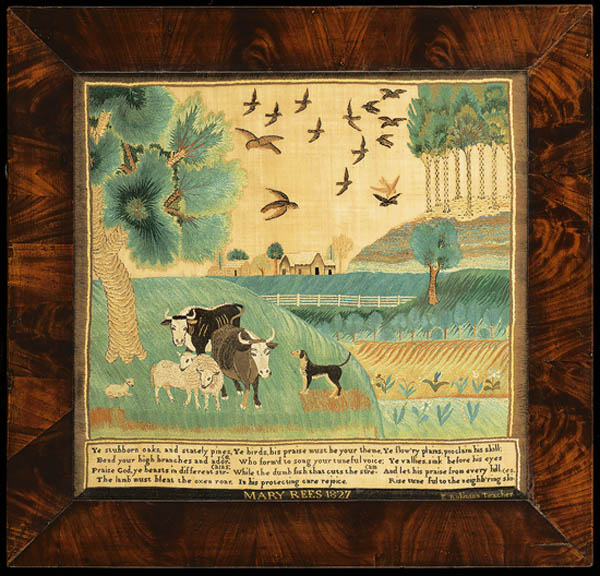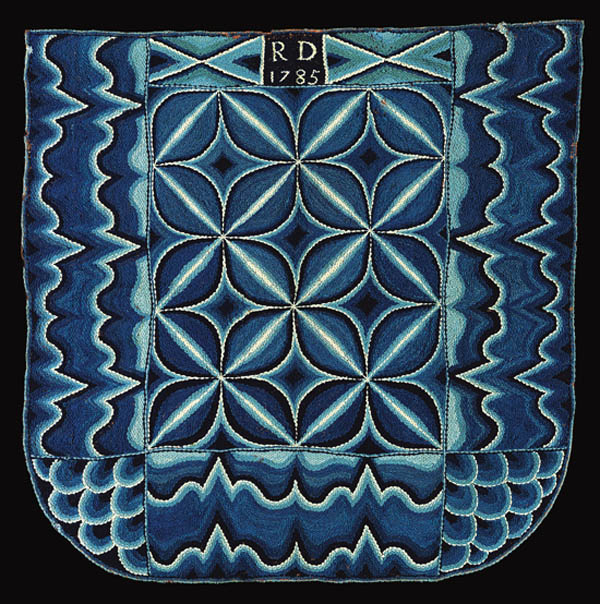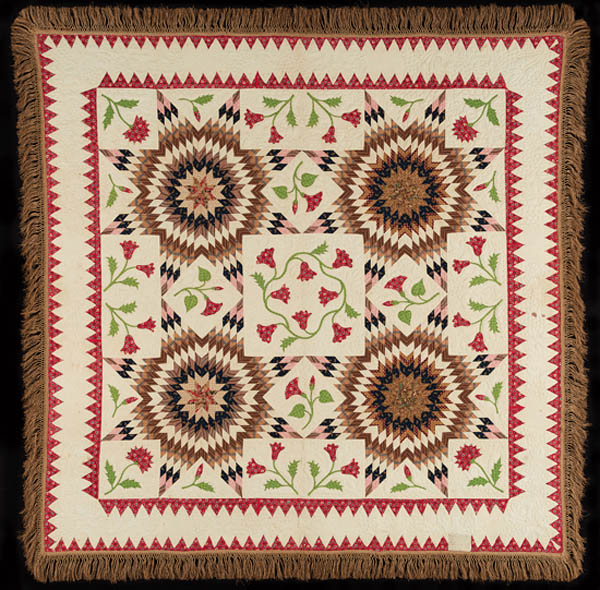Historic Textiles Are Focus Of Two Exhibitions
“Stitched In Time: American Needlework” And “The Art Of The Quilter” On View At Colonial Williamsburg
January 06, 2023
Two new textile exhibitions are open at the Art Museums of Colonial Williamsburg. Stitched in Time: American Needlework, an exhibition of nearly 60 examples of bed rugs, whitework, embroidered hand towels, quilted petticoats, samplers, mourning and commemorative needlework, crewelwork, needlework with religious and geographical influences as well as sewing accessories, will remain on view through Jan. 2, 2025, at the DeWitt Wallace Decorative Arts Museum. Additionally, an entirely new rotation of objects in the popular exhibition, The Art of the Quilter, that opened in 2021 will feature 15 pieces, 12 of which are recent acquisitions that have never before been displayed. This configuration of the exhibition, which will remain on view through August 2023 at the Abby Aldrich Rockefeller Folk Art Museum, will include 11 large quilts, one woven coverlet and three doll-size quilts that tell stories about people from Americas past and the societies in which they lived. For decades, The Colonial Williamsburg Foundation has collected textiles from a broad and highly diverse array of ethnic, cultural, and regional communities, said Ronald L. Hurst, senior vice president for education and historic resources. These new exhibitions allow us to share these beautiful and story-laden documents of early American society with the visiting public. Needlework and sewing were common threads in the lives of most 18th- and 19th-century females across social, economic and geographical boundaries. Early American women, whether poor, enslaved, indigenous, middle class or wealthy, contributed to their familys household furnishings and enriched their homes and clothing by embellishing textiles with decorative stitches. Sewing and mending everyday household textiles, such as bed and table linens and clothing, was another way for women to contribute economically to their family. Stitching needlework projects was not only a creative outlet for many housewives, but was also an educational tool for young schoolgirls. These themes are the basis for Stitched in Time: American Needlework, which will be on view in the Len and Cyndy Alaimo Gallery. The exhibition will also highlight the diversity and regional variations of American needlework that can be traced through the ethnic origins of the makers, trade and migration patterns, influential teachers and artists, current fashions, religious affiliations, geography and even climate. We are excited to share The Colonial Williamsburg Foundations regionally and ethnically diverse needlework collection with our museum visitors, said Kimberly Smith Ivey, senior curator of textiles. Over 50 textiles for comparison have been selected from regions of New England, the Mid-Atlantic, the South and the Western Frontier. Highlights of the exhibition include a schoolgirl sampler created by a young Jewish girl who inscribed her work with her hometown of Chicago. Another extraordinary embroidery was created by an Irish immigrant in Frenchtown, Mich., at the Oblate Sisters of Providence School, which was co-founded by Mother Theresa Maxi Duchermin, a Catholic of color. Among the many other highlights of Stitched in Time is a rare bed rug made probably in Norwich, Conn., in 1785 by an unknown maker who signed the rug RD. The rug relates to a group of embroidered rugs created in the Connecticut River Valley. It was made by darning, or stitching, closely spaced rows of heavy wool yarn through a woolen ground, leaving most of the stitches visible on the surface. The side and bottom borders consist of abstract scalloped and peaked lines similar in appearance to Irish stitch needlework, but worked with darning stitches. This bed rug is especially attractive because of its remarkable condition. Among the many examples of extraordinary samplers in the exhibition is one made in 1827 by Mary Rees, a student of Elizabeth Robinson (1778-1865), in Montgomery County, Pa. Robinson, an unmarried woman who lived with her five unmarried sisters in their family homestead left to them by their father, worked as a schoolmistress to help support the family. At least eight samplers or pictures have been identified from Elizabeth Robinsons school. Mary Rees cross-stitched verse and her pictorial composition made of silk and wool embroidery threads on a linen ground are perfectly suited to each other. The verse implores all living things to praise their Maker, while the imagery shows some of the plants and animals requested to pay such tribute. Rees careful selection of thread color and the direction and type of stitching makes the scene both decorative and naturalistic. The embroidered scene bordered in black stitches to imitate a reverse painted glass mat and the title, date, and signature worked in bright threads to mimic a more expensive gold leaf inscription are characteristics found on other embroideries worked under the instruction of Elizabeth Robinson. In its second year of a three-year exhibition, The Art of the Quilters latest rotation in the Foster and Muriel McCarl Gallery promises to continue delighting quilt aficionados with its new selection of quilts from The Colonial Williamsburg Foundations heralded collection from the early 19th century to present day. These diverse quilts allowed women to express artistic instincts while also creating a warm and practical bedcover for their loved ones. Making quilts was often a community activity, in which neighbors and relatives enjoyed the pleasures of joint work and socializing. Ivey said of the exhibition, We are literally covering America with this exhibition. The bed coverings display a variety of techniques, colors and materials and demonstrate Americas multicultural society with examples from the Anglo-American, German, Amish and Mennonite communities. Among the highlights of The Art of the Quilter is a log cabin show quilt made by Geneva Luela Richards Graves (1862-1915) in Hampshire County, Mass., ca. 1890. During the last quarter of the 19th century, when home decoration and beautification were a primary duty of Victorian housewives, the interest in show quilts reached its pinnacle. Most of these ornamental quilts were smaller than bed-size quilts and were usually made of silks and other fine fabrics with decorative stitches. Genevas small throw, made of rich-colored silk solids, plaids, stripes, textured weaves and velvets, has the additional embellishments of metal bangles and wool, silk and metallic fringe. She worked from the center out to the edges of each smaller unit, building up the design with carefully chosen rectangles of fabric that represent logs of the cabin and purposely selected and assembled her fabrics to create bands of color in a concentric diamond shape. This is the first time this quilt will be on display at the Art Museums since it was acquired in 2020. Stitched in Time is funded by the Leonard J. and Cynthia L. Alaimo Endowment for Colonial Williamsburgs Art Museums, the Jeanne L. Asplundh Textile Exhibitions Endowment and the George Cromwell Trust. The Art of the Quilter is generously funded by the June G. Horsman Family Trust. Stitched in Time and The Art of the Quilter promise to engage and delight the passionate needleworker of today, anyone who has received a special hand-stitched gift from a family member or friend, and all museum visitors of diverse ethnicities from different regions. Additional information about the Art Museums and Colonial Williamsburg as well as tickets are available online at www.colonialwilliamsburg.org.






SHARE
PRINT